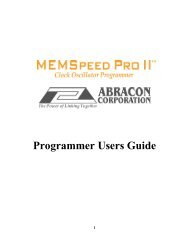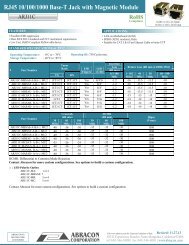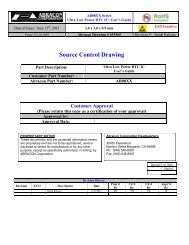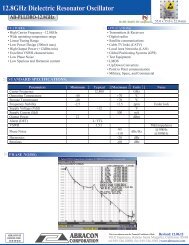ABX8XX-I2C-EVK / ABX8XX-SPI-EVK User's Guide - Abracon
ABX8XX-I2C-EVK / ABX8XX-SPI-EVK User's Guide - Abracon
ABX8XX-I2C-EVK / ABX8XX-SPI-EVK User's Guide - Abracon
You also want an ePaper? Increase the reach of your titles
YUMPU automatically turns print PDFs into web optimized ePapers that Google loves.
AB08XX/AB18XX Real Time Clock Family<br />
Evaluation Kit User’s <strong>Guide</strong><br />
<strong>ABX8XX</strong>-<strong>I2C</strong>-<strong>EVK</strong> / <strong>ABX8XX</strong>-<strong>SPI</strong>-<strong>EVK</strong><br />
markers (+/-) shown in Figure 2. Once the ammeter is connected, change the position of SW1 to the<br />
open position (see Figure 7).<br />
3. Power up the <strong>ABX8XX</strong>-<strong>EVK</strong> and HC development boards.<br />
4. Issue a series of commands to place the <strong>ABX8XX</strong> part in a typical low current oscillation state. The<br />
examples here use the I/O access functions readreg and writereg described in the pseudo code<br />
a. Set the OUT bit (register 0x10 bit 4) to 1 and the OUT1S field (register 0x11 bits [1:0]) to 0 to<br />
insure the OUT1 pin is high and not drawing current through the pullup resistor. Set the OUTB bit<br />
(register 0x10 bit 5) to 1 and the OUT2S field (register 0x11 bits [4:2]) to 0 to insure the OUT2 pin<br />
is high and not drawing current through the pullup resistor. Set the RS1E bit (register 0x11 bit 5)<br />
to 0 to disable the external reset input. This should force the nRST pin to be high and not draw<br />
current through the pullup resistor.<br />
temp = readreg(0x10) // Read the Control1 Register<br />
writereg(0x10, temp | 0x30) // Set the OUT and OUTB bits<br />
temp = readreg(0x11) // Read the Control2 Register<br />
writereg(0x11, temp & 0xC0) // Set the OUT1S, OUT2S and RS1E fields to 0<br />
b. Set the IM field (register 0x12 bits [6:5]) to 0x3. This will minimize the current drawn by the alarm<br />
interrupt pulse generator.<br />
temp = readreg(0x12)<br />
writereg(0x10, temp | 0x60)<br />
// Read the Interrupt Mask Register<br />
// Set the IM field to 0x3<br />
c. Set the TE bit low and the TFS field to 0x3 by writing the value 0x03 to register 0x18. This will<br />
minimize internal current drawn by the Countdown Timer and insure the OUT3 pin is high and not<br />
drawing current through the pullup resistor.<br />
writereg(0x13, 0x03)<br />
// Set the TE bit to 0 and the TFS field to 0x3<br />
d. Set the SQWE bit (register 0x13 bit 7) to 0 to disable the output square wave generator and<br />
insure that the OUT4 pin is not toggling.<br />
temp = readreg(0x13) // Read the SQW Register<br />
writereg(0x13, temp & 0x7F) // Set the SQWE bit to 0<br />
e. To observe the current with the Crystal oscillator running, set the OSEL bit (register 0x1C bit 7) to<br />
0. Note that register 0x1F MUST be written with the value 0xA1 prior to any attempt to modify<br />
register 0x1C.<br />
temp = readreg(0x1C) // Read the Oscillator Control Register<br />
writereg(0x1F, 0xA1)<br />
// Load the Configuration Key Register with 0xA1<br />
writereg(0x1C, temp & 0x7F) // Set the OSEL bit to 0<br />
f. To observe the current with the RC oscillator running, set the OSEL bit (register 0x1C bit 7) to 1.<br />
Note that register 0x1F MUST be written with the value 0xA1 prior to any attempt to modify<br />
register 0x1C.<br />
temp = readreg(0x1C) // Read the Oscillator Control Register<br />
writereg(0x1F, 0xA1)<br />
// Load the Configuration Key Register with 0xA1<br />
writereg(0x1C, temp | 0x80) // Set the OSEL bit to 1<br />
Page (12)








